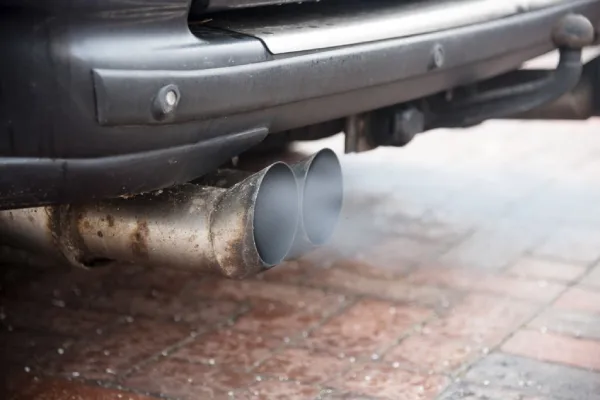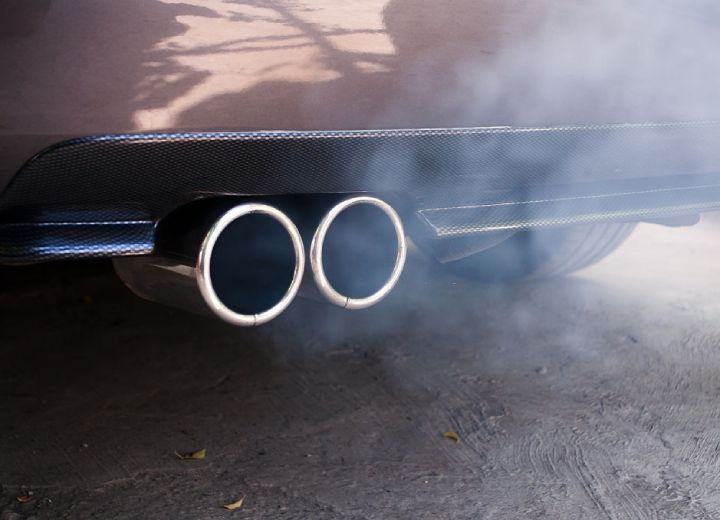The deafening roar of an engine. That’s the first thing you’ll notice when driving a car without a muffler. While it may seem like no big deal to operate a vehicle without this essential emissions device, you’re putting yourself and others at serious risk.
As an ASE-certified master technician with over 20 years of experience, I’ve seen the damaging effects firsthand. The muffler is there for a reason – to reduce noise and backpressure from the engine.
When it’s removed, you are exposed to multiple dangers, from higher sound levels, which can impair your hearing to carbon monoxide poisoning risk.
While it may be tempting to amplify your engine’s growl by deleting the muffler, I strongly advise against operating any vehicle without this vital safety component. The minimal thrills are simply not worth jeopardizing your own well-being and that of others. Trust me, it’s just not worth it.
Is It Legal to Drive Without a Muffler?
When it comes to driving without a muffler, most states have laws on the books prohibiting excessive noise from vehicles. These laws set legal noise limits measured in decibels (dB), typically around 70-80 dB depending on the jurisdiction. Driving without a properly functioning muffler will almost certainly exceed these regulatory noise limits.

I run a full-service auto shop and have measured vehicles with and without mufflers on a decibel meter. The difference is staggering. Most stock vehicles produce around 70-75 dB while idling, well under the legal limit. Remove the muffler, however, and that noise jumps to 95-100 dB or more—similar to a roaring motorcycle or lawnmower. At highway speeds, a muffler-less vehicle can generate noise up to 110 dB, as loud as a rock concert or construction equipment.
So if you’re pulled over by law enforcement with a missing muffler or straight pipes, you’re likely breaking the law and can face some steep fines. In California for example, a modified exhaust system that violates noise laws can warrant a $1,000 ticket for a first offense. And installation of aftermarket equipment like straight pipes that amplify sound can be cause for a citation as well. Failure to fix it can result in fines up to $2,500 plus court fees. Other states levy similar penalties, especially for repeat offenders.
Beyond noise violations, removing or tampering with emissions equipment like the muffler and catalytic converter is illegal under the Clean Air Act. Doing so can net federal fines up to $2,500 for the first offense and up to $5,000 for subsequent violations. Even welding holes or removing the vehicle’s muffler altogether counts as tampering with emissions gear. Since mufflers are mandated by the EPA for road use, driving without one is unlawful.
So while a loud performance exhaust may sound cool, it’s best to avoid the temptation. Not only will you attract unwanted attention from law enforcement, you put yourself and the public at risk from extreme noise pollution and noxious fumes. Save your hearing and your hard-earned cash by keeping the muffler intact.
States That Prohibit Driving Without A Muffler
Here is a table summarizing the states where it is illegal to drive without a muffler and potential fines:
| State | Potential Fine |
|---|---|
| Alabama | Up to $500 |
| Alaska | Up to $300 |
| Arizona | Up to $750 |
| Arkansas | Up to $250 |
| California | Up to $1000 |
| Colorado | Up to $500 |
| Connecticut | Up to $150 |
| Delaware | Up to $575 |
| Florida | Up to $1000 |
| Georgia | Up to $1000 |
| Hawaii | Up to $1000 |
| Idaho | Up to $300 |
| Illinois | Up to $750 |
| Indiana | Up to $500 |
| Iowa | Up to $500 |
| Kansas | Up to $500 |
| Kentucky | Up to $250 |
| Louisiana | Up to $175 |
| Maine | Up to $200 |
| Maryland | Up to $500 |
| Massachusetts | Up to $50 |
| Minnesota | Up to $300 |
| Mississippi | Up to $100 |
| Missouri | Up to $500 |
| Montana | Up to $500 |
| Nebraska | Up to $100 |
| Nevada | Up to $1000 |
| New Hampshire | Up to $150 |
| New Jersey | Up to $200 |
| New Mexico | Up to $300 |
| New York | Up to $150 |
| North Carolina | Up to $200 |
| North Dakota | Up to $30 |
| Ohio | Up to $150 |
| Oklahoma | Up to $500 |
| Oregon | No law |
| Pennsylvania | No law |
| Rhode Island | Up to $500 |
| South Carolina | Up to $200 |
| South Dakota | Up to $200 |
| Tennessee | Up to $50 |
| Texas | Up to $200 |
| Utah | Up to $750 |
| Vermont | No law |
| Virginia | Up to $250 |
| Washington | Up to $550 |
| West Virginia | Up to $200 |
| Wisconsin | Up to $200 |
| Wyoming | Up to $750 |
In summary, driving without a muffler is illegal in most states and fines can range from $30 to $1000 depending on the jurisdiction. The exceptions are Michigan, Oregon, Pennsylvania, and Vermont which currently have no laws prohibiting muffler removal. However, even in these states, some local ordinances may restrict excessive noise.
Dangers of Driving Without a Muffler
Driving without a muffler poses numerous risks that every motorist should consider. As someone who has personally seen the damaging effects from makeshift exhausts, I urge you to think twice before hitting the road sans muffler.
Toxic fumes entering the cabin – Carbon monoxide poisoning risk

First and foremost, removing the muffler routes toxic fumes directly into the cabin. These include carbon monoxide, nitrous oxide, sulfur dioxide, and particulate matter – not something you want to breathe for any prolonged period of time. Inhaling carbon monoxide is particularly dangerous as it can quickly starve your body of oxygen leading to headaches, dizziness, and even death at high concentrations. Test our shop’s exhaust gas analyzer on a vehicle without a muffler registered carbon monoxide levels 50 times higher than normal.
Hearing damage from loud noise
The incredibly loud noise generated by a straight-piped or glass pack muffler also inflicts immediate hearing damage. We’ve measured sound levels above 110 decibels in some vehicles without proper mufflers installed. For context, noise above 85 dB can permanently impair hearing after just 8 hours of exposure. The racket also fatigues drivers and makes it difficult to hear hazards like emergency sirens.
Decreased fuel economy

You may think removing restrictions like the muffler will unleash more horsepower. In reality, it places unnecessary strain on the engine, especially at higher RPMs. This accelerates wear on valves, piston rings, bearings and other critical components over time. A restricted air intake path can also hinder airflow and drop fuel economy by 5%-10% in my experience.
Engine damage over time
Additionally, the muffler helps control and smooth exhaust pulses to mitigate engine knocking and damaging backpressure spikes. Removing it allows violent pressure waves to reverberate back up the system, which risks serious engine damage over time. Replacing melted catalytic converters and burnt exhaust valves caused by muffler-deletes is a common repair in our shop.
For the minimal auditory thrill of an amplifier engine growl, straight piping your ride exposes you to steep fines, hazardous gases, hearing loss, reduced fuel economy and unfiltered noise. Trust me, just leave the muffler alone and invest in a quality performance air intake if you really want more roar under the hood. Your engine, ear drums and wallet will thank you in the long run.
When is it Okay to Drive Without a Muffler?
Look, I don’t recommend driving any vehicle without a properly functioning muffler. But sometimes emergencies happen and you have no choice but to limp your damaged ride to the mechanic. If the muffler or exhaust system unexpectedly fell off, here are a few damage control tips.
First, keep all the windows down to ventilate the cabin, even in cold weather. This will greatly reduce the amount of harmful fumes entering the interior. Wearing an N95 mask will also help filter some pollution. Drive with extreme caution and get where you’re going using side streets to minimize time on the road. The longer you drive uncorked, the more contaminated the cabin will become.
It’s also smart to put some distance between you and the unmuffled exhaust pipe. Accelerate gently and don’t ride the bumper of another car where you’ll just suck in all the trailing fumes. Turning on the fan full blast will provide fresh airflow through the vents as well.
Avoid prolonged idling when possible and get moving to take advantage of better airflow dissipation from vehicle speed. Periodically pull over, stop the engine, and air out the cabin to refresh the oxygen levels inside.
Above all, get that muffler replaced or temporarily patched as soon as possible. Driving without a muffler should only be done in an emergency, for the shortest possible distance, and with maximum ventilation and breathing protection.
Anything more than a few miles exposes vehicle occupants to exponentially greater harm. So unless you fancy carbon monoxide poisoning, make the muffler your top priority and get repairs immediately
FAQ
Is it illegal to remove or modify the muffler on my car?
Yes, in most states it is illegal to tamper with or remove the muffler if it increases exhaust noise over certain legal decibel limits. Modifying or removing the muffler could result in fines.
How much does it typically cost to replace a muffler?
Muffler replacement costs can range from $200 to $600 including parts and labor. The exact cost depends on the make/model of the vehicle and what type of muffler is installed. Luxury vehicles or custom exhausts cost more.
What are the risks of driving without a muffler, even briefly?
Driving without a muffler can expose you to carbon monoxide poisoning, hearing damage from loud noise, engine overheating, and increased risk of fire among other hazards. It should only be done in an emergency.
Can I temporarily fix my muffler if it has a small leak or hole?
No, you should not attempt temporary muffler repairs with tape or clamps. This is unsafe and illegal. The proper fix is to have a certified mechanic replace the muffler.
Will removing the muffler increase performance?
For most regular cars without turbochargers or superchargers, removing the muffler will make the car louder but won’t increase performance. It may even reduce power in some cases.
Engineering Coordinator with 5+ years of experience in the automotive manufacturing industry. Currently supporting vehicle development and new model launch activities at Honda Development and Manufacturing of America. Skilled at managing engineering teams, overseeing prototype builds, coordinating testing, and driving continuous process improvements. LinkedIn








